What is marketing automation?
Marketing automation refers to software platforms and technologies designed for marketing teams to effectively market their products/services on multiple channels and automate repetitive tasks. It involves email marketing, social media scheduling, sales pipeline management, running and monitoring ad campaigns, managing leads, analyzing campaign sources, ROI, and more.
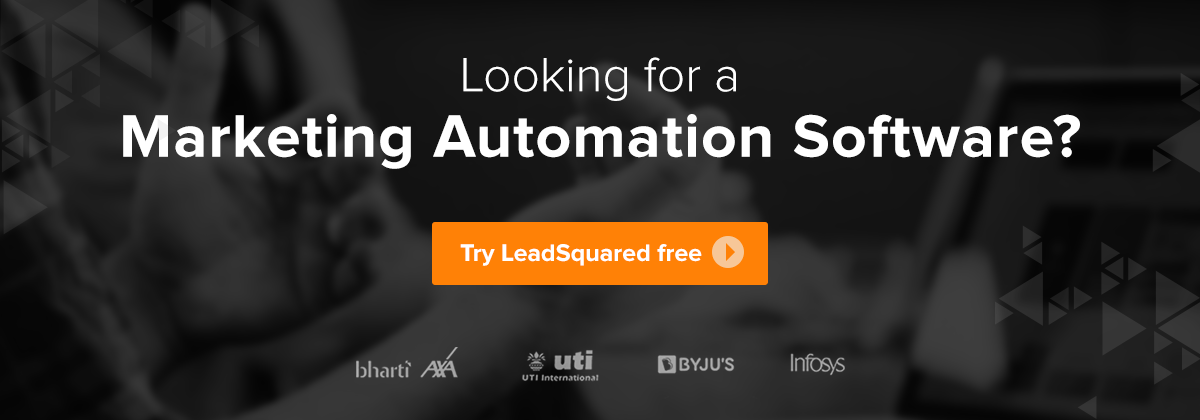
With marketing automation, you can automate routine tasks and improve your team’s productivity. In this world of eCommerce and digital customer interactions, marketing automation has a direct impact on sales. For instance, a customer buying a product after clicking on the discount offer email reflects the direct impact of marketing automation on sales. Knowing exactly how it moves the needle for your business is the key to running successful marketing automation campaigns.
In this article, we will talk about the different aspects of marketing automation. But first, let us look at how it impacts business ROI.

Understanding Marketing Automation
People often use the term email marketing interchangeably with marketing automation. But that is not correct. While intelligent, personalized email marketing is a part of marketing automation, it is not its only function.
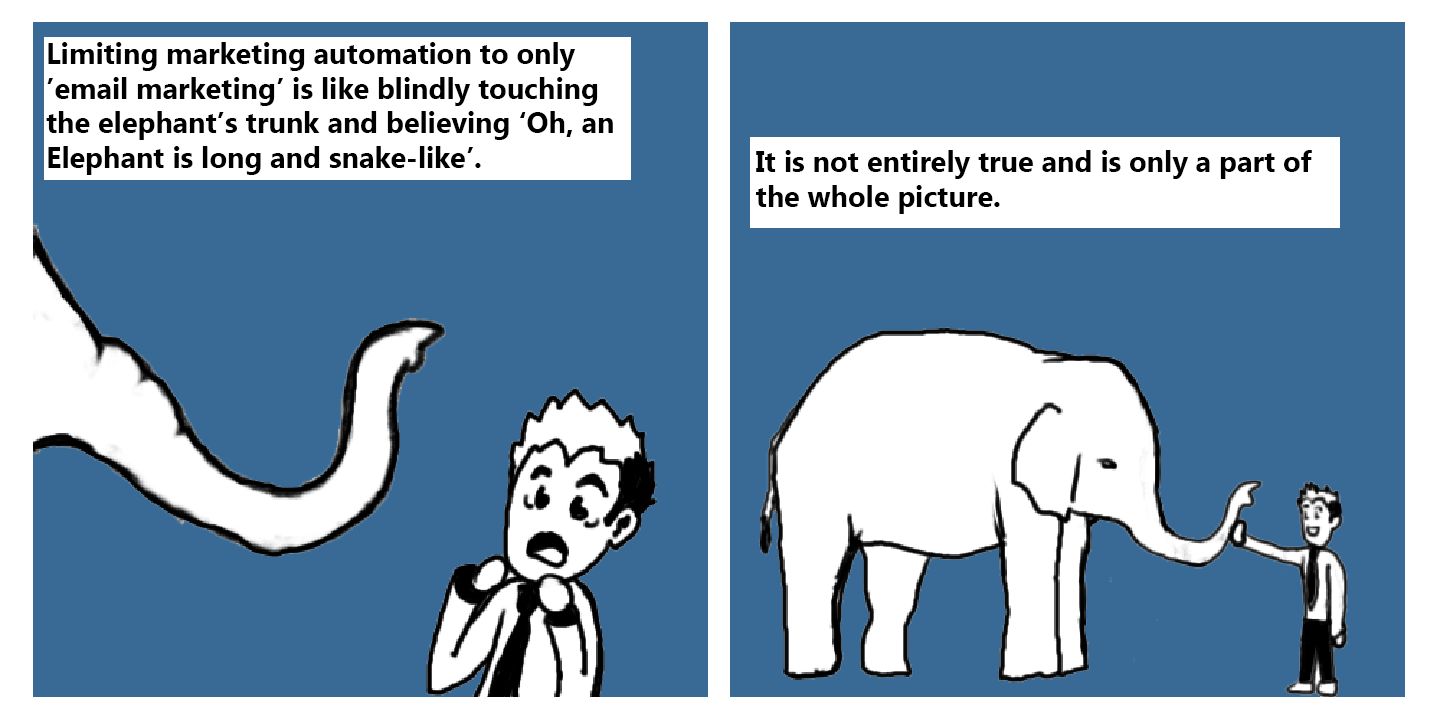
Marketing automation also involves tracking leads, qualifying them, triggering relevant communication actions based on activities, and passing leads on to the sales team at the right time. If the leads/prospects are not sales-ready, then marketing automation also takes care of nurturing them based on their activities, or inactivity – until they show an interest in your product/service.
How does marketing automation help?
Marketing Automation software automates all marketing actions that map and influence the prospect journey and guide a lead down the conversion funnel. It saves the marketer a lot of time. Thus, enabling him to focus more on building marketing strategies instead of working on repetitive tasks.
In general, marketing automation includes the following tools:
- Landing pages, telephony, and integrations with all your marketing channels to capture leads.
- Drip marketing and email campaigns to help you nurture leads with the right content at the right time.
- Lead scoring for lead qualification
- Conversation tracking at each touchpoint – phone calls, SMS, emails, social, web chat, etc.
- Website tracking and lead segmentation to understand the intent of a lead, and ensure that the lead gets targeted content.
- Opportunity management to identify and act upon upselling/cross-selling opportunities.
- Reporting and Analytics to identify gaps and positives in your process and learn and improvise accordingly.
So, can marketing automation replace marketers?
Nope.
Marketing automation is not a substitute for your marketers. That is, you cannot introduce a marketing automation software one day and then fire half your team. The purpose of marketing automation software is to eliminate repetitive tasks and allow your team to work more efficiently. It will help you ensure that every conversation is highly relevant, personalized, and timely – irrespective of the channel that the prospect chose to communicate. Furthermore, your team can measure the impact of their campaigns and automate lead engagement workflows as well.
With marketing automation in place, your team can engage with leads in a more personalized way, leading to better customer experience at every step.
Marketing Automation in Action
Here is an example of an email that I got recently:
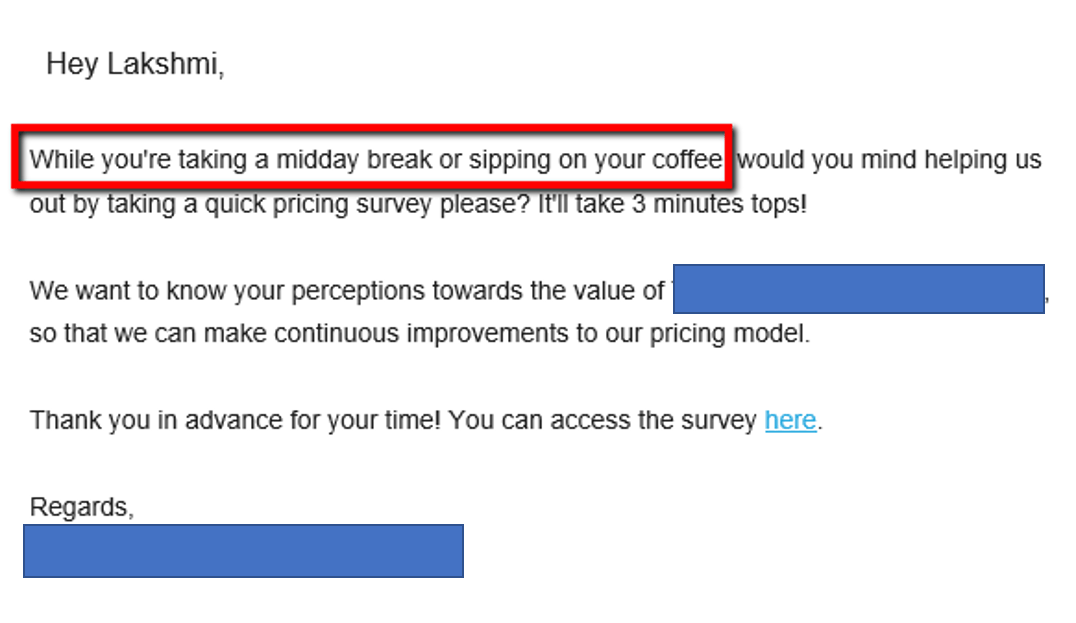
What struck me most about this email was that they timed it with my midday break! And do you know what I did? I went ahead and took the survey.
Let us explore why this email was a success.
Sent at the right time
Had I not gotten this email during my midday break; it would not have had much of an impact. The sender timed the email to coincide with my break time. See, I am not saying they knew my exact timetable and thus sent the email. They just sent it at the time when it would have had maximum impact.
However, finding the right schedule may not be that simple. They would have done a few things to get it right. For instance, based on their experience with previous campaigns, they would have noticed that the email sent at a particular time slot gets a higher open rate.
The have complimented this learning with a cleverly worded email that would encourage the recipient to take an action (click on the email). For instance, they might have said “While you sip your evening tea” had they sent the email at 5.
Lesson learned: Use marketing automation tools to determine the best time to send emails depending on your target audience.
Relevant content
They asked me to take a survey about their pricing. The brand knew that I had evaluated their product recently and was aware of their pricing structure. If I had only downloaded an e-book, this email would not have been relevant to me, and I would have just skipped it.
So, they have probably segmented their lead list and ensured that this email reached only the relevant leads.
Personalization
Now, this is the easy part. The brand got my name right. I wasn’t just ‘Hi Subscriber’ to them. And yes, that did make a difference.
In short, the email was timely, targeted, and personalized, which is why it had an impact. All successful email campaigns share these traits.
[Also read: Email Marketing Best Practices I Learnt After Sending 2,049,567 Emails]
I also brought up the topic because I wanted to tell you that you can achieve all of these with marketing automation. You can segment your lead list, personalize the content (with mail merge fields), and make sure the content is relevant.
But these are still the capabilities of an email marketing tool. Why do you need marketing automation software for this?
It is because marketing automation will not only help you execute these tasks automatically but also refine them further.
Let us take the same example. When you want to nurture your leads with targeted content and push them down the funnel, you will probably face the following problems:
Understanding lead requirements
If you don’t use a tracking software, you will not know your prospects’ interest in specific products/services, unless they mention it explicitly. Sending an email blast about Offering A will be pointless to leads interested in Offering B and vice versa.
Similarly, in your lead list, if you do not know who has downloaded an e-book and who has examined your pricing page, you are aiming blindfolded. Sending an email blast about pricing will be irrelevant for those subscribers who have not checked out your pricing page yet.
Sending emails (nurturing leads) after an important activity
Even if you manage to send relevant content, you will also have to send it at the time that makes the most sense for the lead. Bombarding their inbox with emails for each website visit or an inconsequential action will make even the most interested leads immune to your content. For instance, the total number of emails (B2B and B2C) sent and received per day exceeded 293 billion in 2019. However, according to spamlaws.com, 45% of emails were spam. Moreover, 73% of email users don’t hesitate to click the unsubscribe link to get rid of unwanted emails.
You would not want a tuned-out audience, right?
That is why you need to segment your email list based on interest, demographics, and preferences and send emails accordingly.
Check this out:
The more the lead interacts with your business, the more targeted your content should be. That means, each follow-up email should be in response to their previous activity (or inactivity).
Look at the following emails. In the first email, the brand has sent an eBook to their subscribers. The subsequent email was sent in response to the people who have read the first email.
Email #1:
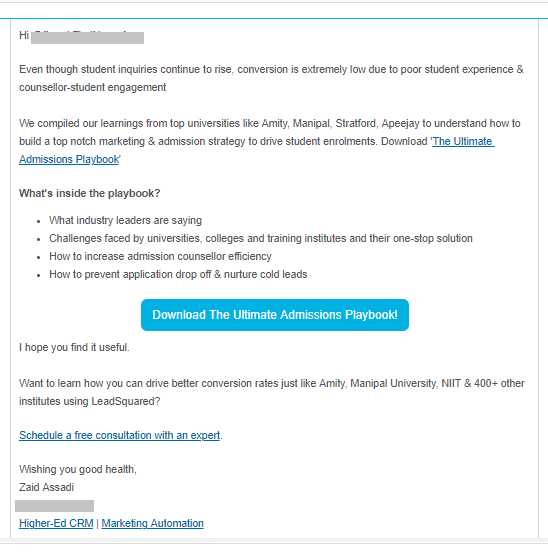
Email #2:
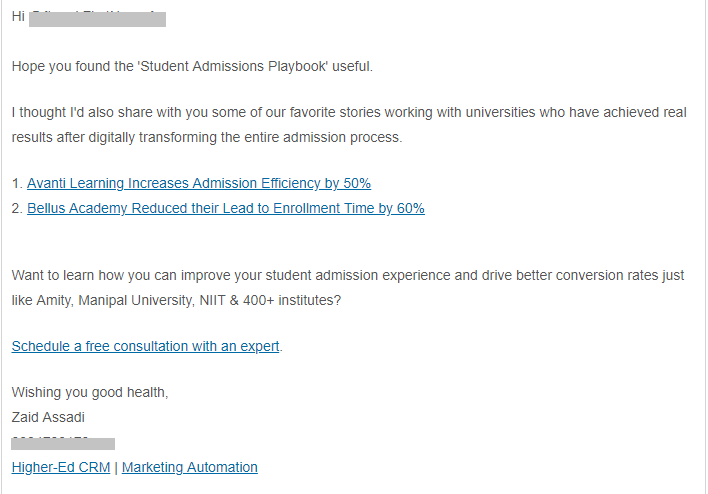
There is another benefit of automation in day-to-day marketing activities.
By tracking the website activity, you can identify the lead source, interests, and active hours. It will help you figure out the best time to send relevant emails to your leads.
Once you send out the email, you will know how each lead responds to the email (Do they open it? Do they click on the link?) and use this information to further nurture them. You can also take it a step further and notify the salesperson if the lead has taken a conversion-centric action.
Of course, as with any marketing tool, the email statistics after each campaign will show you how the email has performed. It will also give you an overview of how each lead reacted to the email, that is, opens, clicks, best performing subject lines and more.
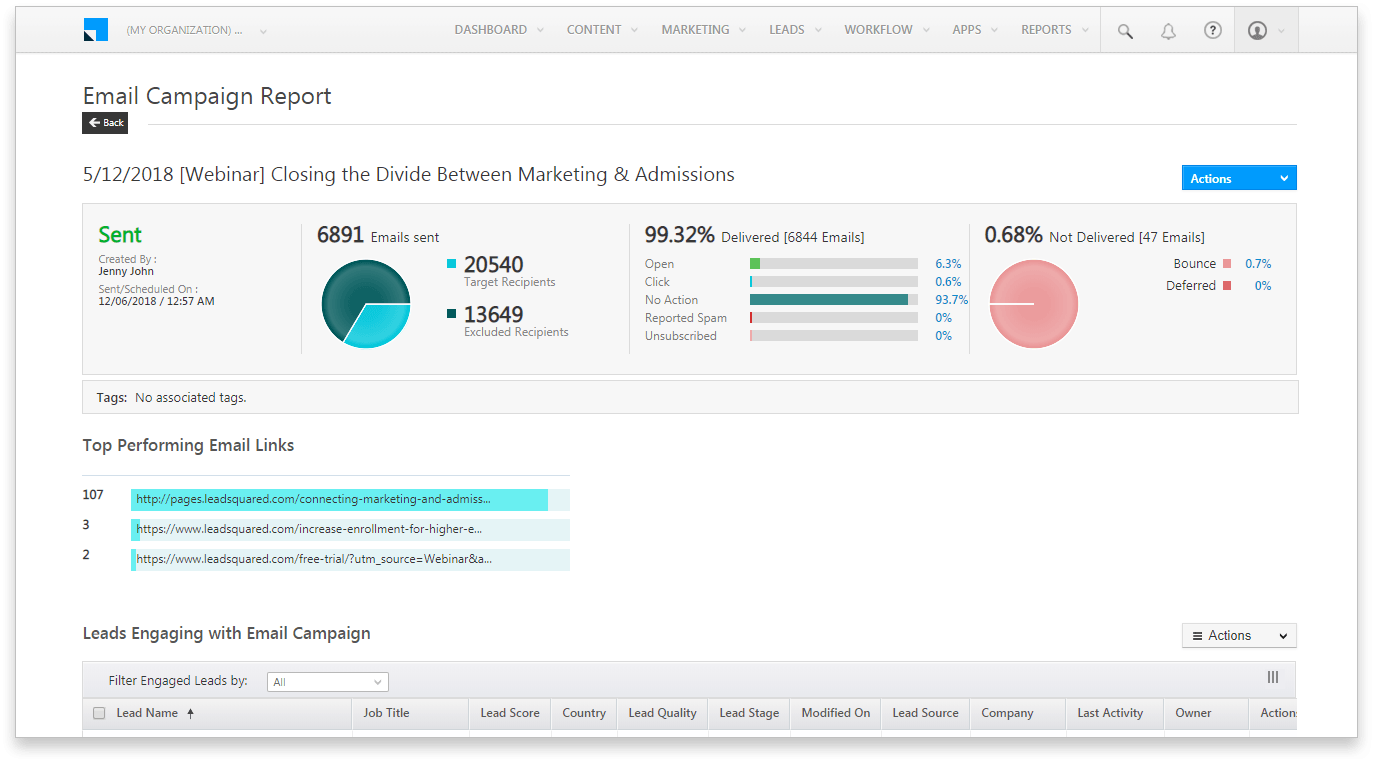
Checking if the lead is sales qualified
The point of nurturing is to make the lead sales-qualified and push them further down the conversion funnel. But how will you know if the email campaign you sent out has finally convinced your lead to check out your product? This feature is not present in all email marketing tools. However, with marketing automation, it is possible.
By tracking the lead score (and sometimes engagement score), you can identify when the lead is sales-ready.
If the lead is more involved with your content, you can gauge the intent of the conversion. Moreover, based on the lead source, their response to the nurturing activities, the pages they visit on the website etc., your marketing automation software can automatically move them up/down the sales funnel.
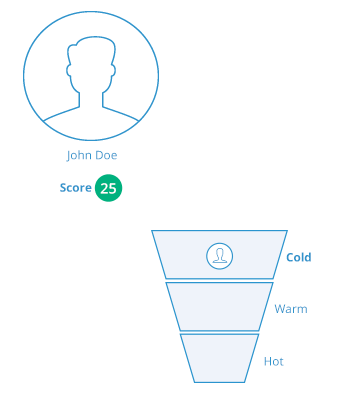
[Also read: MQL vs SQL: Difference between them and how to convert more MQLs into SQLs.]
Tracking the impact of marketing activities:
So how exactly did your marketing efforts impact business? Did it improve lead generation? Did you get in more quality leads? What is your high-performing lead channel?
Well, your marketing automation tool can answer all these questions, and more.
The reporting and analytics tell you which was your best performing campaign.
But my personal favorite is the report that tells me the response time. The fact of the matter is lead response time impacts buying decisions a lot. According to a report from Invesp, 35-50% of sales go to the vendor that responds first. Marketing automation software can show you these metrics. Once you have a clear picture, you can fix the bottlenecks and promptly respond to the lead inquiries.
You must have noticed that marketing automation software automates engagement. That is, marketers need not sit, and draft campaigns based on prospect activities. You can create a flow beforehand, which runs automatically as and when a user takes an action.
Look at this example of marketing automation workflow in heath insurance segment.
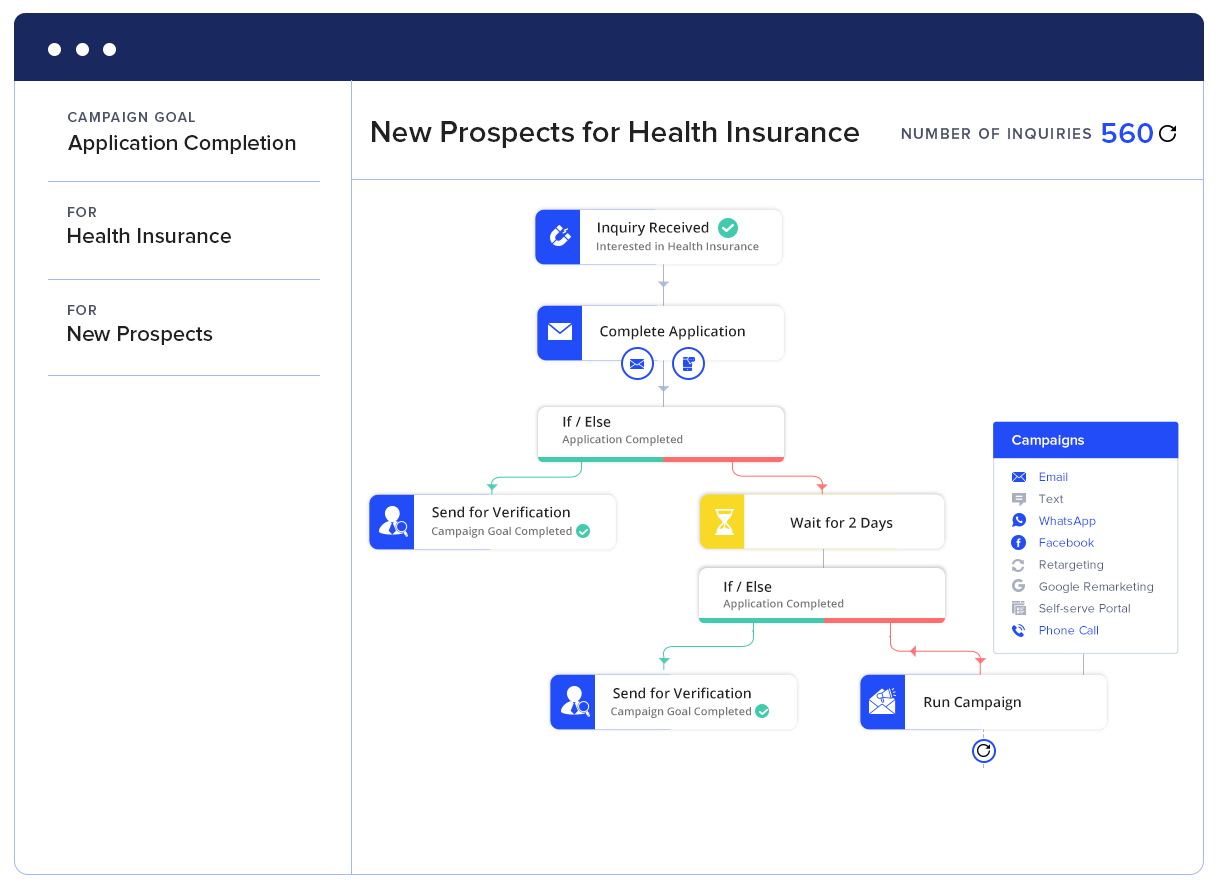
Also, note that email is just one of the options. You can schedule campaigns on several different channels based on the choice of your recipients.
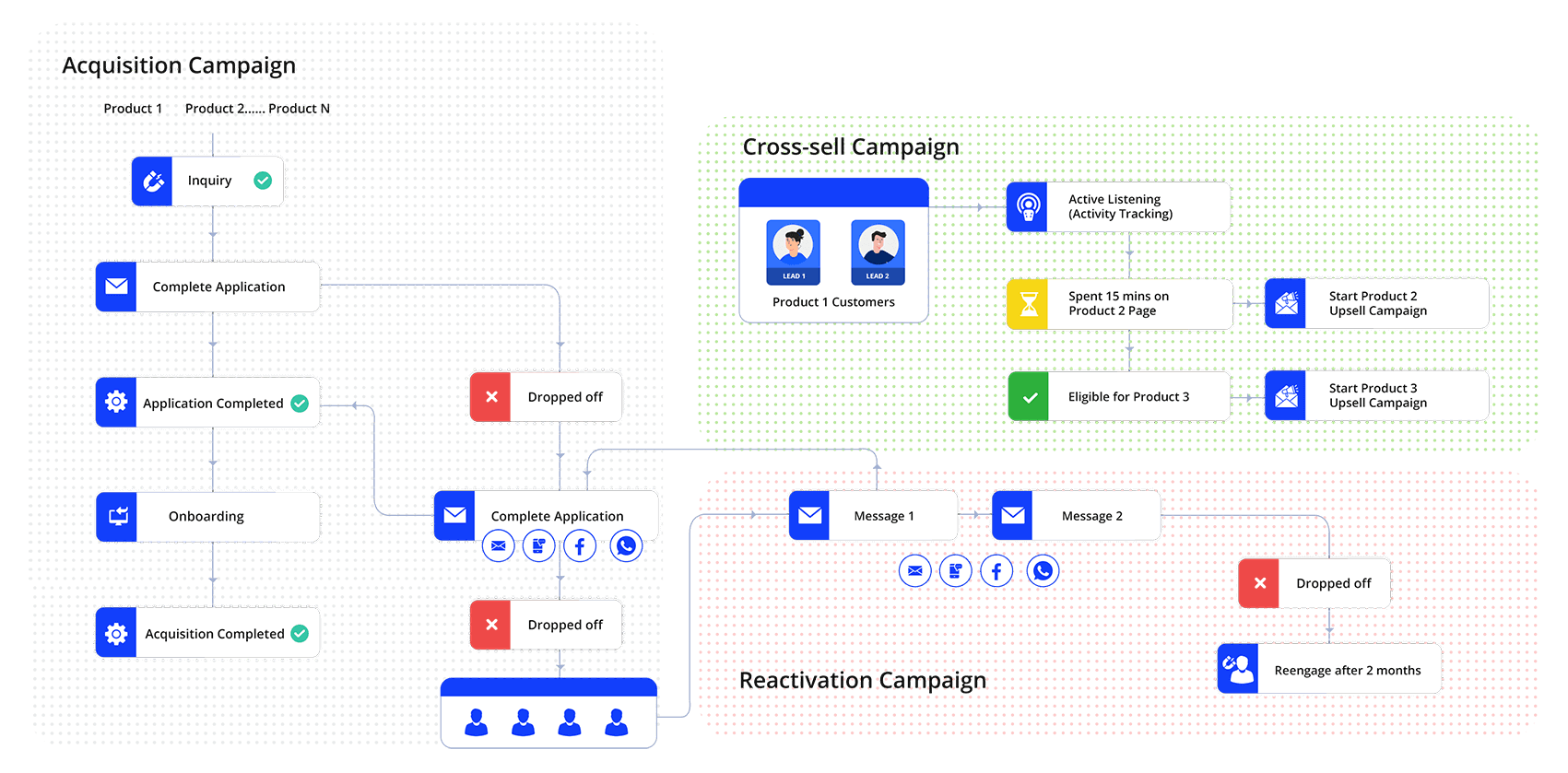
Why Marketing Automation?
Marketing automation indeed helps you improve lead engagement, makes your team more productive, and boosts ROI.
But this is only one half of the story.
Another reason why you should get marketing automation is for a better customer experience. If you see from the customer perspective, a successful campaign looks like this:
- Emails are sent only at a time when it is most convenient to the recipient.
- No unnecessary spam. The emails are highly relevant and interesting.
- No pestering calls from sales to buy.
- The sales guy always knows the customer requirements – customers need not repeat things.
- The process is fast- customers get acknowledgments and replies instantly.
In short, it is a seamless journey that gives the lead more reason to buy from you.
And that is why marketing automation is such a good idea. It does not just help your marketing team – it also impacts the user experience and interaction with your business that will otherwise be very difficult to monitor.
That is the real reason to get a marketing automation tool – to build lasting relationships with your leads and customers.
If you are still wondering whether to go for marketing automation or not, try out the LeadSquared Marketing Automation suite once. Explore yourself how it:
- Reduces lead leakage to zero with landing pages, connectors, APIs, and more.
- Shows buyer intent with a 360-degree user profile, behavior, activity, and social tracking.
- Visualize user journeys.
- Send relevant content right at the right time to drive sales.
- Triggers engagement across all channels and devices – emails, text messages, social, phone calls, and portals.
- Measures performance and gives prescriptive insights across lead sources, engagement campaigns, and user journeys.
FAQs
Digital marketing automation refers to the process and software tools designed to plan, execute, and manage marketing campaigns on multiple online channels, such as email, ads, social media, websites, etc., track lead journey, and trigger activity-based communications.
The best marketing automation tool will let you capture leads from different sources, track customer journey to understand their intent, trigger engagement actions, seamlessly integrate with other software systems, and measure campaign performances. LeadSquared Marketing Automation Suite is one of the best marketing automation tools trusted by 1000+ businesses.









